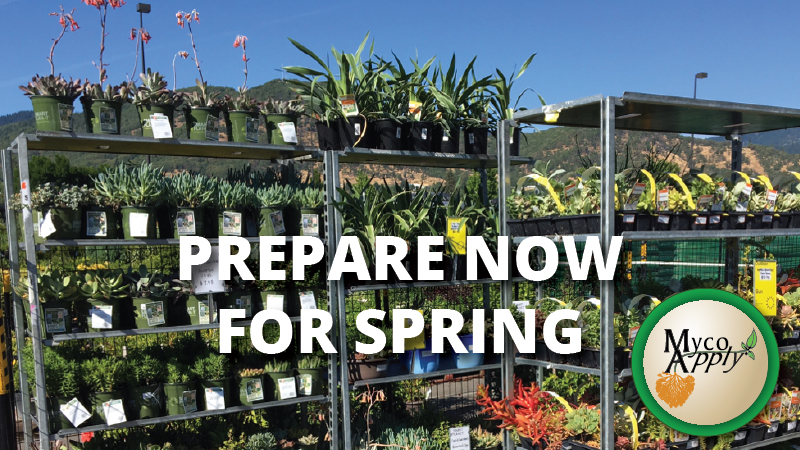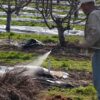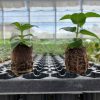
For many growers, July marks the end of one growing year and the beginning of another. At that time preparations for the next Spring begin in earnest. I have often thought Cultivate was the mental milestone for this transition. As part of your spring planning, it is important to decide where you plan to incorporate mycorrhizae in your production protocols.
Propagation is the best step in the production process to incorporate mycorrhizae. The reasons to support this statement are many. I will focus on the top two reasons. It starts with economics, growers only need to treat the propagation soil volume as opposed to the finished plant’s soil volume if treated later during production. If a plant is treated during propagation, the mycorrhizal relationship stays with the plant throughout the rest of the plant’s life. Plants only need to be treated once with mycorrhizae if they are allowed to keep their existing root ball as they transition to a larger container. Timing is the second reason supporting application during propagation. The symbiosis between a plant and mycorrhizae takes three to four weeks to establish. If this time period is during the propagation stage, then the plant is fully mycorrhizal as the plug/liner is transplanted into a finished or transitional container. Growers can benefit from less transplant shock and a more uniform crop as they work to finish the plants. If growers are growing a quick annual crop, and if they wait to apply the mycorrhizae during the finishing stage, the grower does not often hold on to the plants long enough to see the visible benefits from the use of the mycorrhizae.
Fortunately, there are several options growers can consider on how to incorporate mycorrhizae during propagation. Options even exist for growers that purchase in their plugs and liners.
Soil Incorporation
For those growers that make their own propagation soil blend or have the luxury of a spare hopper in their soil line if they purchase a pre-mixed growing media, incorporation should be considered an ideal choice. Growers can select from a granular product like MycoApply Endo or a powdered product like MycoApply Ultrafine Endo. Both are OMRI listed and available in 40 and 20 lb. bags respectively.
Plug/Liner Dip
Smaller growers have come to embrace the practice of dipping their purchased-in plug/liner trays before they plant the plants into a finished container. The good news is that mycorrhizae can be added to your dipping tray solution. MycoApply Ultrafine Endo in 1 lb. bags is often the preferred choice. The one-pound bag can make 40 gallons of drench. Since the mycorrhizae are on a clay carrier and the mycorrhizae go into suspension and not into solution, it is important to have constant agitation to keep the mycorrhizae readily available in the plug dip solution.
Drench
Most medium to larger growers opt to drench their plants with mycorrhizae during propagation. Mycorrhizal Applications has made it easy by developing two products specifically designed for use via a horticultural injector. MycoApply Injector Endo is now OMRI Listed and will be the most commonly selected product. Nursery and Christmas Tree growers will want to select MycoApply Injector Ecto. Both products use a humic acid as a carrier that readily goes into solution. These highly concentrated products only require 20 grams of material to make 100 gallons(379 liters) of solution. In Canada, growers can purchase and use MycoApply SuperConcentrate 10. This OMRI Listed product has a clay carrier but behaves like the Injector products. Injector Endo and Ecto are available in 100-gram packages and comes with a 20-gram scoop. SuperConcentrate 10 is available in ½ lb.(0.227 kg) bottles and comes with a 20-gram scoop. When applying mycorrhizae, it is important to remove the bottom screen of your injector (similar to what you might do with beneficial nematodes), since the mycorrhizal propagules are solid and need an opening of at least 50 mesh (297 microns) to pass through.
Fertilization and Drench Combo
MycoApply EndoThrive is a game-changer. This non-aqueous liquid version of mycorrhizae can be used as a traditional drench treatment. But the game-changer is that it can also be used in combination with a fertilizer application. The combination of activities allows for potential reduction in labor and the ease of use of a liquid. EndoThrive can be added to and stored in a fertilizer stock tank. If used within a several-month period and with agitation, the mycorrhizae and fertilizer combination option could be an excellent choice for many growers.
Boom Sprayer Application
One of the key criteria used by Mycorrhizal Applications in developing MycoApply Injector Endo, Injector Ecto, SuperConcentrate 10, and EndoThrive was that these formulations could successfully be used via a boom sprayer. Application sheets have been developed for each of the products to support usage via a boom sprayer.
Fall Booking Program
Once you have your plan assembled on how you plan to incorporate mycorrhizae into your production protocols, the next step is to purchase the needed products. Fortunately, Mycorrhizal Application’s distributors are offering discounts on orders placed for MycoApply through the end of November for Winter and early Spring 2022 deliveries. Please check with your preferred distributor for details. A list of MycoApply distributors can be found on our website.
If you have any questions about anything covered in this article or MycoApply Mycorrhizae, please contact your local Mycorrhizal Applications Representative or call 866-476-7800 or email us at inquiries@mycorrhizae.com.






